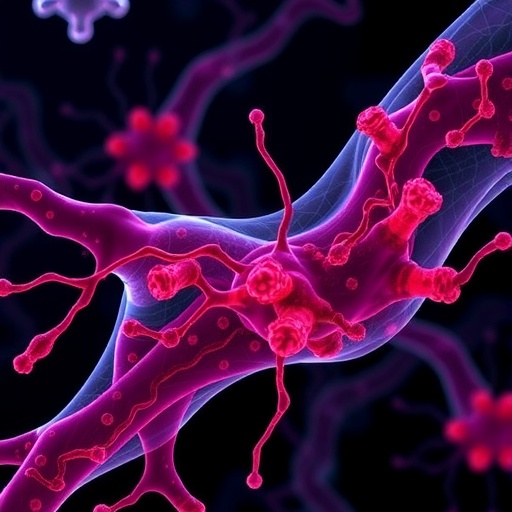In a groundbreaking revelation, a team of researchers led by Chen, RQ., Liu, PJ., and Li, S. has unveiled crucial insights into the healing processes of tendon-related diseases through the lens of macrophage regulation. This study highlights the intricate relationship between immune responses and tendon repair, offering a potential paradigm shift in how we approach treatments for these common, yet often debilitating, injuries. The findings, published in the latest issue of Military Medicine Research, mark a significant advancement in regenerative medicine and trauma rehabilitation.
Tendons, the robust connective tissues that attach muscles to bones, play an essential role in human movement and strength. However, injuries to tendons can lead to chronic pain and compromised mobility, affecting both athletes and everyday individuals alike. Conventional treatments often focus on rest and rehabilitation; however, they frequently fall short in addressing the underlying biological mechanisms involved in tendon healing. This necessitates a more profound understanding of the cellular interactions that govern tendon regeneration, prompting researchers to explore the role of macrophages in this process.
Macrophages are well-known as vital components of the immune system, acting as the body’s first line of defense against pathogens. However, their role transcends mere immunological responses. Recent studies have illuminated macrophages’ involvement in tissue repair and regeneration, particularly in how they modulate inflammation and influence healing outcomes. In the context of tendon injuries, macrophages have been implicated in orchestrating both the initial inflammatory response and the subsequent regenerative processes.
The study conducted by Chen et al. meticulously examined the various populations of macrophages present during tendon healing phases. Two primary macrophage phenotypes were identified: the pro-inflammatory M1 macrophages and the anti-inflammatory M2 macrophages. The distribution and activity of these macrophages changed significantly during the healing timeline, highlighting the dynamic nature of the cellular environment in tendon injuries. This shifts in phenotype suggest that strategic manipulation of macrophage activity could enhance recovery and healing efficiency.
Intriguingly, the research indicates that M1 macrophages, while essential for initiating the healing process, can impede tendon repair if their presence is not adequately regulated. Excessive inflammation caused by prolonged M1 activity can lead to fibrosis and reduced tendon elasticity, ultimately resulting in poorer outcomes for patients suffering from tendon injuries. Conversely, M2 macrophages promote tissue repair and regeneration, suggesting that therapeutic strategies aimed at enhancing M2 activity could provide a novel approach to treating tendon-related diseases.
The authors highlight several critical pathways through which macrophages influence tendon healing. By analyzing cytokine profiles and genetic expression in macrophages harvested from injured tendons, the study offers a detailed look at how these immune cells communicate with other cell types involved in the repair process. In particular, signaling molecules like IL-10 and TGF-β were shown to be instrumental in fostering a beneficial microenvironment for tendon repair by encouraging M2 polarization of macrophages.
One particularly compelling aspect of this research is the potential therapeutic applications that may arise from better understanding macrophage dynamics in tendon healing. For example, targeted therapies that could selectively promote the M2 macrophage phenotype or inhibit the detrimental effects of M1 macrophages could change the landscape of treatment strategies. This might pave the way for novel biological therapies that could be integrated into existing rehabilitation protocols, providing patients with more effective options for recovery.
The implications of this research extend beyond tendon injuries alone. The principles uncovered in the healing dynamics of macrophages could have applications in other tissue repair contexts, such as muscle, skin, and cartilage injuries. By harnessing the body’s immune system, future treatments could enhance natural healing processes, reducing the need for invasive surgical interventions and improving overall patient outcomes.
In exploring the broader implications, the study raises essential questions about the integration of immunological responses into current treatment paradigms for tendon injuries. As the field of regenerative medicine continues to advance, incorporating insights from immunology may provide a more holistic understanding of recovery processes. This approach could encourage reconsideration of existing protocols, emphasizing the need for therapies that promote optimal immune responses in tandem with physical rehabilitation efforts.
Moreover, the findings from this research align with a growing recognition of the interconnectedness of immune health and musculoskeletal integrity. As the understanding of macrophage roles in healing evolves, it becomes increasingly clear that a multi-faceted approach—combining molecular biology with clinical application—will be essential for improving outcomes for patients with tendon-related diseases. The work of Chen et al. serves as a seminal reference point for researchers striving to bridge basic science discoveries with therapeutic innovation.
Overall, Chen, RQ., Liu, PJ., and Li, S. have laid the groundwork for an exciting new direction in the treatment of tendon-related diseases, providing critical insights into macrophage regulation’s role in healing. By highlighting the significance of macrophage polarization and its implications for tendon repair, this study opens new avenues for research and therapeutic development. The findings will undoubtedly inspire follow-up studies and interdisciplinary collaboration aimed at translating these insights into clinical practice.
The study serves as a powerful reminder of the complexities of biological systems and the potential for targeted interventions to enhance healing. As new techniques and therapies are developed, it will be crucial for researchers and clinicians to remain informed and adaptable, utilizing the latest discoveries in the field to provide the best possible care for patients. The future of tendon healing and regeneration may indeed lie within the intricacies of macrophage regulation—a frontier that promises exciting developments in the quest for effective treatment options.
Subject of Research: The role of macrophage regulation in the healing of tendon-related diseases.
Article Title: Healing of tendon-related diseases: insights from macrophage regulation.
Article References: Chen, RQ., Liu, PJ., Li, S. et al. Healing of tendon-related diseases: insights from macrophage regulation. Military Med Res 12, 45 (2025). https://doi.org/10.1186/s40779-025-00635-x
Image Credits: AI Generated
DOI: 10.1186/s40779-025-00635-x
Keywords: Tendon healing, Macrophage regulation, M1 macrophages, M2 macrophages, Regenerative medicine, Immune response, Tissue repair, Cytokines, Inflammation, Therapy developments.




